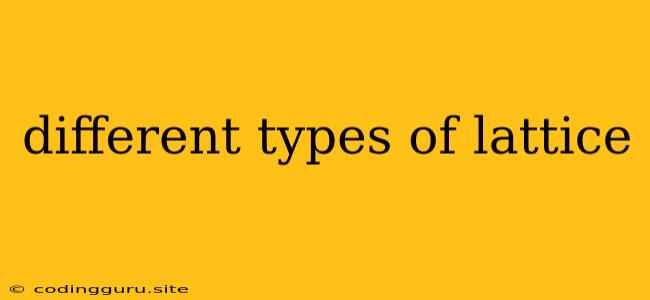Different Types of Lattices: A Comprehensive Guide
The term "lattice" can refer to various structures in different fields. Let's explore the different types of lattices across various disciplines:
1. Crystal Lattices in Physics and Materials Science:
At the core of our understanding of solids lies the concept of a crystal lattice. These lattices are three-dimensional arrays of points that represent the periodic arrangement of atoms or molecules within a crystal. Understanding the different types of crystal lattices is crucial for predicting and controlling the properties of materials.
a) Bravais Lattices:
Bravais lattices are the simplest and most fundamental types of crystal lattices. They are characterized by their unique symmetry properties. There are 14 distinct Bravais lattices in three dimensions:
- Cubic: This lattice has cubic symmetry, with all three axes equal in length and mutually perpendicular. There are three types of cubic lattices: Simple Cubic (SC), Face-Centered Cubic (FCC), and Body-Centered Cubic (BCC).
- Tetragonal: Similar to cubic but with one axis different in length.
- Orthorhombic: Three axes are unequal in length, but all are perpendicular.
- Rhombohedral: Three axes are equal in length, but all are not perpendicular.
- Hexagonal: This lattice has a hexagonal base and a single axis perpendicular to it.
- Monoclinic: Two axes are unequal in length and perpendicular to each other, while the third axis is oblique.
- Triclinic: All three axes are unequal in length and inclined at different angles.
b) Non-Bravais Lattices:
These lattices can be generated by adding additional points to the Bravais lattices. They are not considered fundamental but are important for understanding more complex crystal structures.
2. Lattices in Mathematics:
In mathematics, a lattice refers to a partially ordered set that satisfies certain properties.
a) Distributive Lattice:
In a distributive lattice, the distributive laws hold:
- a ∧ (b ∨ c) = (a ∧ b) ∨ (a ∧ c)
- a ∨ (b ∧ c) = (a ∨ b) ∧ (a ∨ c)
b) Modular Lattice:
A modular lattice satisfies a weaker condition than the distributive property:
- a ≤ c ⇒ a ∨ (b ∧ c) = (a ∨ b) ∧ c
c) Boolean Lattice:
A Boolean lattice is a special type of distributive lattice that has a unique least element (0) and a unique greatest element (1).
3. Lattices in Computer Science:
In computer science, the term "lattice" is used to describe a data structure that represents a partially ordered set. It's often used in database management, optimization, and program analysis.
a) Galois Lattice:
A Galois lattice is used to represent the relationships between sets of objects and sets of attributes. This lattice helps understand the dependencies between objects and attributes in a dataset.
4. Other Types of Lattices:
- Lattice Structures: These refer to physical structures that have a lattice-like arrangement. Examples include lattices used in construction, fences, and other engineering applications.
- Neural Networks: Some artificial neural network architectures use "lattice" layers to process information in a structured way.
Key Considerations for Different Types of Lattices:
- Symmetry: The symmetry properties of lattices play a crucial role in determining their physical and chemical characteristics.
- Dimensions: Lattices can exist in different dimensions, from one-dimensional chains to three-dimensional crystals.
- Applications: Understanding the different types of lattices is essential for various applications, including materials design, database management, and machine learning.
Conclusion:
The term "lattice" is used in diverse fields, each with its own specific interpretation and applications. Whether it's a crystal lattice describing the arrangement of atoms in a solid or a Boolean lattice representing logical relationships in computer science, understanding the different types of lattices is crucial for tackling various scientific, engineering, and computational problems.
